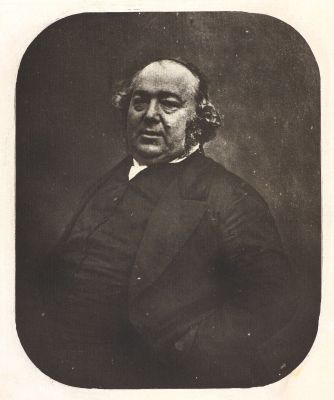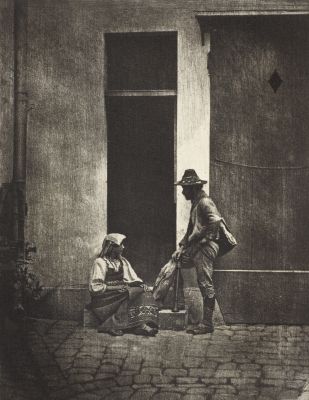
Title
Théophile GautierArtist
Nadar (Gaspard-Félix Tournachon) (French, 1820-1910)Publication
Charles Nègre Treize Héliogravures 1854-1857Date
1982 plate (1857 negative)Process
PhotogravureAtelier
L'Atelier de Saint-Prex, SwitzerlandImage Size
17.8 x 23.9 cm
Négre was sought after by other photographers because his photogravure process could make their work more permanent. On 18 March 1856, Ernest Feydeau, the archaeologist and novelist, invited him to lunch and introduced him to Auguste Salzmann (French, 1824 1872), who wanted Négre to print his photographs of Jerusalem. By 1857, Nadar (French, 1820-1910) had sent him portraits of Lamartine and of Theophile Gautier in oriental costume for photogravure reproduction. The printer Lemercier, the Revue photographique of 5 April 1857 claimed, was waiting impatiently for Negre to make photogravure plates of breeding livestock by Nadar. Borcomen p. 44
This print is included in the portfolio, Charles Négre Treize Héliogravures, 1854-1857 commissioned by André Jammes in 1982 and printed from Négre’s original steel plates. Introducing the project, Jammes writes… Charles Nègre (1820-1880) was one of the most influential photographers of the 19th century. Painter turned genre and architectural photographer, as early as 1855 he brought the hand-pulled photogravure process to an extraordinary degree of perfection. His work in photogravure is classical in the history of photography. The present portfolio demonstrated his successive trials, from the modest “Maçon accroupi” published in La Lumière in 1854, to the large-scale plates of Chartes cathedral, which may be considered his masterpieces. It also includes three Nadar portraits. Produced in 1982 by the renowned connoisseur of 19th century photography and owner of Negre’s original plates, André Jammes, this portfolio is held in the permanent collection of the Metropolitan Museum of Art as well as the National Gallery of Canada. At Saint-Prex, in Switzerland, there is an exceptional experimental atelier where numerous innovative techniques are being essayed, including the revival of photographic etching. It was therefore only natural to have the old steel plates of Charles Nègre printed in the mot favorable condition at this atelier. These thirteen plates are printed from the original steel plates made 125 years ago. The printing methods are absolutely similar to those employed in the XIXth century… A special ink adapted to each plate has to be devised, a very powerful and precise press used, and a hand-made paper produced, covered with “chine collé” according to the methods so appreciated by the Romantics. … This portfolio is a resurrection undertaken in a spirit of scrupulous honesty, presenting images faithful to the old proofs, which now are almost impossible to locate at any price.
The portfolio is held by the Musée d’Orsay, the National Gallery of Canada, the National Gallery of Art (Washington, D.C.), the Metropolitan Museum of Art, and the J. Paul Getty Museum, among others. Unusually for modern iterations of extant vintage prints, it is held not as rare reference material in these institutions’ special-collections libraries, but as part of their photography collections.
The 2 plates of Chartres are some of the largest photogravures made in the 19th century and represent the zenith of Nègre’s achievement.
The thirteen plates are presented in a box with three compartments (86 x 67 cm.), containing the two large-size plates, the 11 smaller ones, and descriptive and historical notes. The edition is limited to 110 copies, 100 of which are for sale. An original etching by Charles Nègre, engraved from the famous self-portrait drawing of Ingres, is included in the text.
Reproduced / Exhibited
Malcolm R. Daniel, and Florian Rodari. Graver La Lumière: L’héliogravure D’alfred Stieglitz À Nos Jours Ou La Reconquête D’un Instrument Perdu. Vevey, Suisse: Fondation William Cuendet & Atelier de Saint-Prex, 2002. p. 98
Françoise Heilbrun, Charles Nègre photographe 1820-1880 (Paris: Éditions des Musées nationaux, 1980)
National Gallery of Canada Accession number PSC90:009:1-14
MET Accession Number: 1983.1168.1–.14
National Gallery of Art Accession Number 2008.138.1.1-14
Getty Object Number: 84.XM.692.10
Musée d’Orsay Accession number PHO 1983 23











